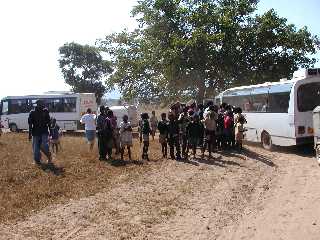
Sohwe Primary. So we must be near Sohwe falls, right? I don't think the kids here had ever before seen so many strangers.

HartRAO Home > news > Total Solar Eclipse - Zimbabwe 2001/06/21
The University of Witwatersrand Planetarium organised a week long tour through Zimbabwe to see the total solar eclipse. The trip actually consisted of two groups -- a bus tour with the passengers accomodated at various lodges and a self-drive camping tour. We (Sharmila & Andrew Goedhart) were on the camping tour. It was a wonderful experience. The local people were very friendly and despite all the fears about petrol, we had no trouble filling up. It was only possible to get unleaded petrol in the main towns though, so we were glad we got our car converted to take leaded petrol.
The lodge housing the bus tour outside of Harare had prepared a picnic and viewing site somewhere near Sohwe Falls for us. So all we had to do was get ourselves and our equipment there. We joined up with the bus tour at 8 am the morning of the eclipse and proceeded in convoy to the viewing site. We expected at most a 3 hour drive on tarred roads. There was some sort of miscommunication about the route we were supposed to take and so we ended up about 200 km east of the planned venue and just 20 km south of the Mocambique border. Fortunately this placed us right on the center line of totality, so no one cared that lunch was nowhere to be found.
The little town (village?) of Dotito was our last sight of tarred road. This also had the only road block where we were stopped by the police and asked to produce our passports. There were also shady operators here who were attempting to sell tickets to see the eclipse! They seemed to be sort of associated with the police so some people got intimidated into paying 250 Zim dollars for a ticket (the tickets were a roll of $1 tickets of the sort that you could buy at a stationary shop). After some discussion with the police we eventually got them to admit that we were free to go after they had checked our passports. We were most disgusted with the whole situation but I must stress that this was our only negative experience in the whole trip.
I think I can say that we got lost after we left the tar road at Dotito. It must have been around 12:30 at this stage. We decided to just follow the buses and not worry any more. We were in the path of totality and that was all that mattered.

After much driving around we found ourselves near a little village on a plain near the mountains. The eclipse was about to start and this looked like a good spot to watch it from. At this stage everyone was incredibly keyed up.
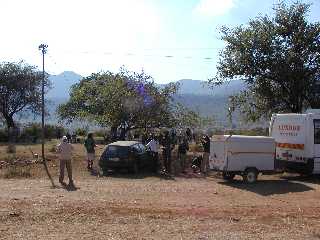

A few minutes after first contact. Two large sunspot groups can
be clearly seen.
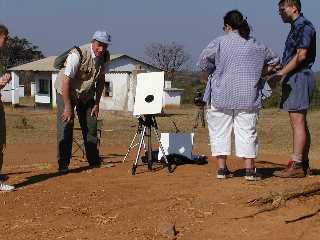
Projecting the image of the sun through binoculars and onto a
screen. This is the only safe way to view a magnified image of the
sun. We had an alarming moment when one of the locals tried to look
through the binoculars. If he had not been stopped he would have had a
good chance of being blinded.

Showing the locals the image of the partial phase.
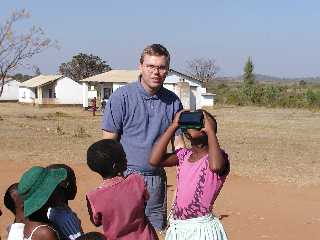
Andrew getting the local kids to look at the sun through #14
welders glass.
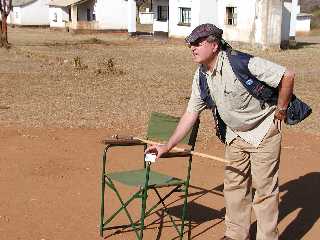
Using a mirror to reflect an image of the sun onto a white screen.

The mirrored image projected onto a bus.
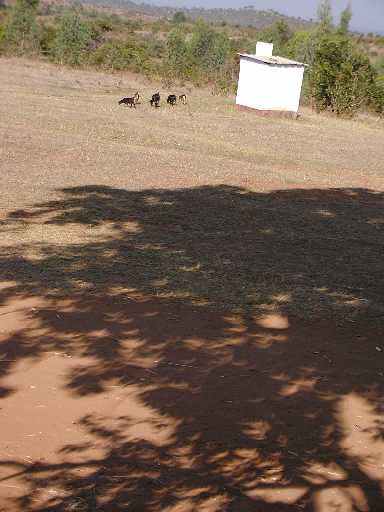
Sun dapples on the ground. By this stage it was noticably
colder.
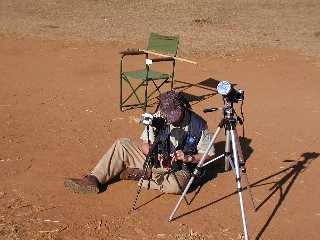
Cameras fitted with home-made filters. The camera on the left
has a filter taken off a pair of solar viewing glasses. The camera on
the right is using mylar film. This is the camera I used to take some
images of the eclipse. I just let the camera decide on the exposure
times. During totality we removed the filters in order to get images
of the corona.
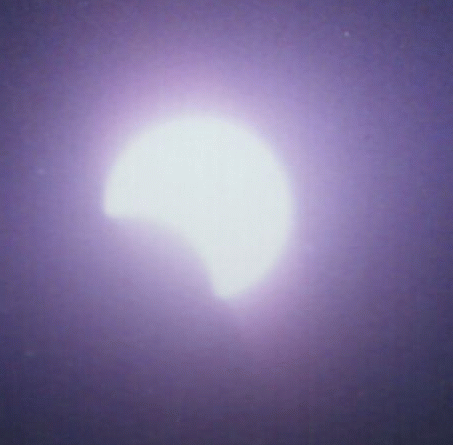
The eclipse is well on its way. This image is overexposed but
you get the idea.
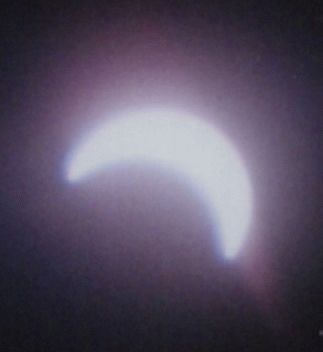
A little later. The time is about 14:50.
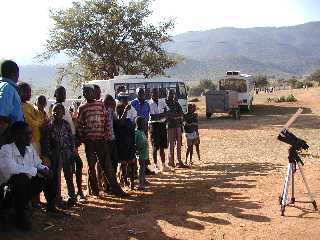
A few minutes before totality. The villagers are fascinated.
They were in such a remote area that they were not supplied with solar
glasses.
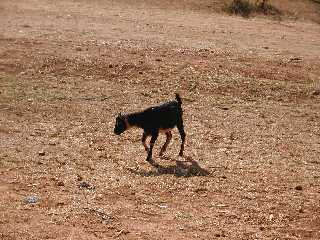
Its getting quite dark and cold. The goats decide its time to go
home.

Almost there. I've got to remember to breathe!

And its happened! I'm so excited I drop the solar filter when
taking it off the camera.
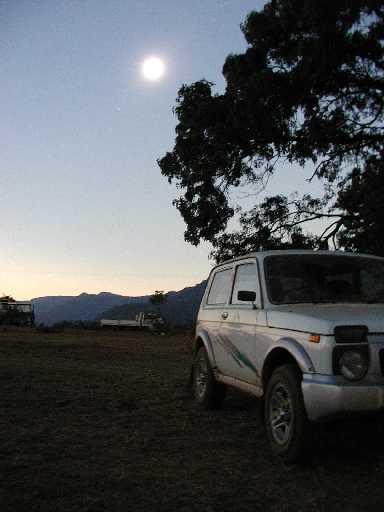
Andrew is running around taking lots of shots with the digital
camera. This is an image taken with our Olympus C2100-Z digital camera
during totality using the program settings. Unfortunately the sun's
corona is overexposed. Jupiter can be seen to the lower left of the
sun. Notice how dark the sky is. Sunset colours can be seen on the
horizon. All was quiet except for the sound of a drum and a blowing
conch from the Aztec thanksgiving ceremony. Yes, we had an Aztec
shaman and his apprentice from Mexico doing a sun-worship ceremony in
"darkest Africa". The locals abandon our projection screen in favour
of seeing what the Indians are up to. I decide to go over and have a
look during the last minute of totality. I'm amazed that I did not
trip over a rock. I couldn't take my eyes off the sun.

At the time I never did manage to find out why the Indians were in
Zimbabwe for the eclipse. I gathered that they were doing a ceremony
of thanks-giving to the sun. For more information, go to their sponsors . They started
before first contact and carried on until after last contact. Having
them with us really made for a unique eclipse experience. I wonder
what the local villagers made of it all?
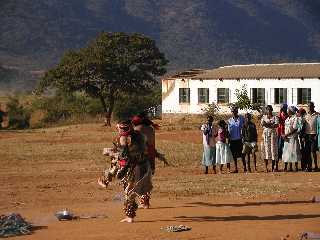
The villagers appear to be greatly entertained.
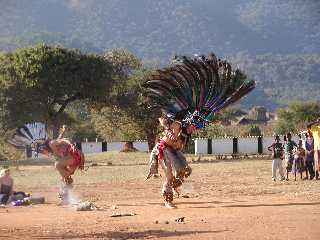
The shaman with his headress of feathers.

The dancing became very frenzied after totality. At this stage I
saw the villagers getting ready to slaughter a goat. I decided I did
not really want to know any more about that.
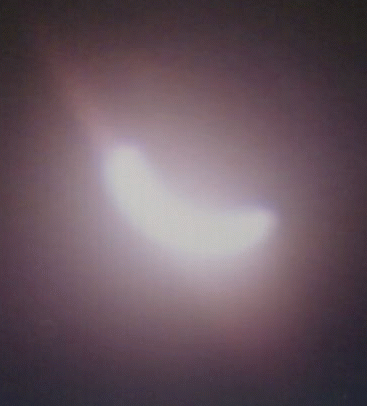
The rest of the eclipse just does not seem so interesting anymore.
Totality was just too short.

The last picture we take before packing up. Its a long drive back
to Harare and we've got to move camp to join the others.
Watching totality was an amazing experience. No photos can ever do it justice (especially not mine!). I am now totally addicted. Next year I think you will find me in Mocambique chasing the next eclipse in Southern Africa.
For more eclipse photos see our report from Lusaka.
HartRAO helped to bring the eclipse to Sowetans. See Partial eclipse as seen from Soweto..